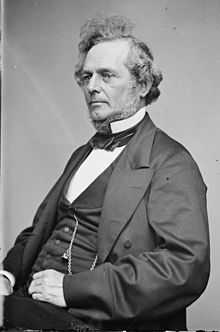Richard March Hoe
| Richard March Hoe | |
|---|---|
 Richard March Hoe | |
| Born |
September 12, 1812 New York City |
| Died |
June 7, 1886 (aged 73) Florence, Italy |
| Nationality | American |
|
Engineering career | |
| Significant design | Rotary printing press |
| Significant advance | Printing press |
Richard March Hoe (September 12, 1812 – June 7, 1886) was an American inventor who designed an improved printing press.
Biography
Hoe was born in New York City. He was the son of Robert Hoe (1784–1833), an English-born American mechanic who, with his brothers-in-law, Peter and Matthew Smith, established a steam-powered manufactory of printing presses in New York City, which Richard joined at fifteen. He became a senior member of his father's firm in 1833. On his father's death, he became head of the R. Hoe & Company. Richard Hoe died on June 7, 1886, Florence, Italy.
Inventions
In 1843, Richard invented a rotary printing press that placed the type on a revolving cylinder, a design much faster than the old flatbed printing press.[1] It received U.S. Patent 5,199 in 1847, and was placed in commercial use the same year. In its early days, it was variously called the "Hoe lightning press," and "Hoe's Cylindrical-Bed Press," and was later developed into the "Hoe web perfecting press."

In 1870 he developed a rotary press that printed both sides of a page in a single operation. Hoe's press took a roll of paper five miles long, which was put through the machine at the rate of 800 feet (240 m) a minute. As the sheets came out, they were passed over a knife which cut them apart, and then they were then run through an apparatus which folded them for the mail or for carriers. These completely printed and folded newspapers were delivered as quickly as the eye could follow them.[2]
Early on, Hoe added the production of steel saws to his business and introduced improvements to their manufacture. In 1837, he visited England and obtained a patent for a better process of grinding saws. In connection with his factory, Hoe established an apprentice's school where free instruction was given.[2]
Hoe was a Freemason, and died in Florence, Italy. His nephew, Robert Hoe (1839–1909), wrote a notable Short History of the Printing Press in 1902 and made further improvements in printing.
Hoe estate
Hoe lived with his wife, Mary, on a vast 53-acre (210,000 m2) estate, called Brightside, in the Morrisania / Hunt's Point section of the Bronx. The estate was sold in 1904 by his family to developers speculating on the subway extension into the Bronx. His mansion was located at present day Printers Park at the corner or Aldus Street and Hoe Avenue in the Bronx. The newly reconstructed park opened in April 2010, equipped with a play structure inspired by the rotary printing press.[3]
References
- ↑ Meggs, Philip B. (1998). A History of Graphic Design (Third ed.). John Wiley & Sons, Inc. p. 147. ISBN 978-0-471-29198-5.
- ↑ 2.0 2.1
 Wilson, James Grant; Fiske, John, eds. (1900). "Hoe, Robert". Appletons' Cyclopædia of American Biography. New York: D. Appleton.
Wilson, James Grant; Fiske, John, eds. (1900). "Hoe, Robert". Appletons' Cyclopædia of American Biography. New York: D. Appleton. - ↑ NYC's Printers Park at cityroom.blogs.nytimes.com.
External links
![]() Media related to Richard March Hoe at Wikimedia Commons
Media related to Richard March Hoe at Wikimedia Commons
- An illustration of the Hoe web perfecting press.
-
 "Hoe (family)". New International Encyclopedia. 1905.
"Hoe (family)". New International Encyclopedia. 1905. -
 "Hoe, Richard Marsh". Encyclopedia Americana. 1920.
"Hoe, Richard Marsh". Encyclopedia Americana. 1920. -
 "Hoe, Richard Marsh". Collier's New Encyclopedia. 1921.
"Hoe, Richard Marsh". Collier's New Encyclopedia. 1921. - Old House on the Property of West Farms, Residence of R.M. Hoe by D.J. Kennedy, Historical Society of Pennsylvania
|